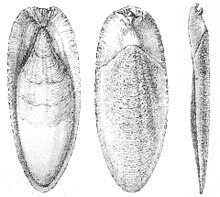
Back لسان البحر Arabic Os de sípia Catalan Sépiová kost Czech Schulp German Jibión Spanish کف دریا (سپیداج) Persian Valaansuomu Finnish Sépion French Tulang sotong ID Osso di seppia Italian





Cuttlebone, also known as cuttlefish bone, is a hard, brittle internal structure (an internal shell) found in all members of the family Sepiidae, commonly known as cuttlefish, within the cephalopods. In other cephalopod families it is called a gladius.
Cuttlebone is composed primarily of aragonite. It is a chambered structure that the animal can fill with gas or liquid for buoyancy control. On the ventral (bottom) side of the cuttlebone is the highly modified siphuncle; this is the organ with which the cuttlebone is filled with gas or liquid.[2] The microscopic structure of cuttlebone consists of narrow layers connected by numerous upright pillars.
Depending on the species, cuttlebones implode at a depth of 200 to 600 metres (660 to 1,970 ft). Because of this limitation, most species of cuttlefish live on the seafloor in shallow water, usually on the continental shelf.[3]
When the cuttlefish dies, only the cuttlebone remains and will often wash up on a beach.
- ^ Fuchs, D.; Engeser, T.; Keupp, H. (2007). "Gladius shape variation in coleoid cephalopod Trachyteuthis from the upper Jurassic nusplingen and Solnhofen plattenkalks" (PDF). Acta Palaeontologica Polonica. 52 (3): 575–589.
- ^ Rexfort, A.; Mutterlose, J. (2006). "Stable isotope records from Sepia officinalis — a key to understanding the ecology of belemnites?". Earth and Planetary Science Letters. 247 (3–4): 212. Bibcode:2006E&PSL.247..212R. doi:10.1016/j.epsl.2006.04.025.
- ^ Norman, M.D. (2000). Cephalopods: A world guide. Conch Books.

